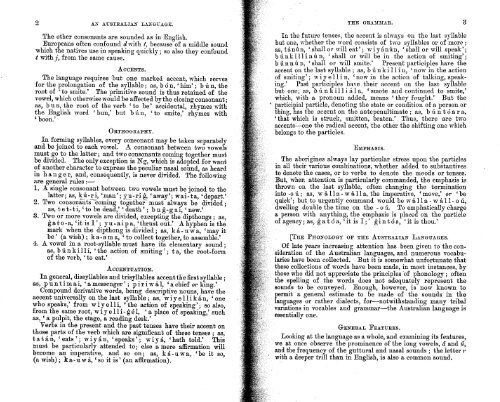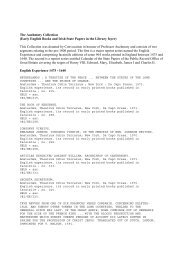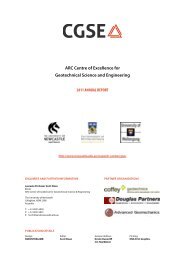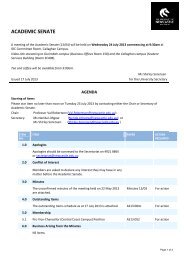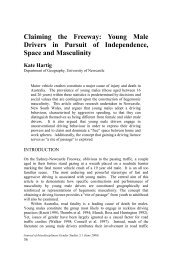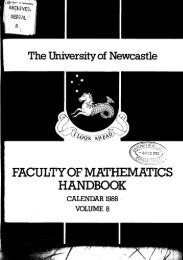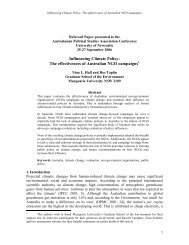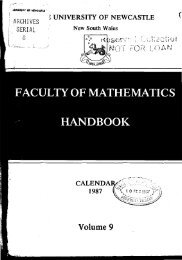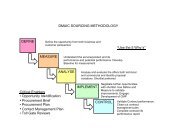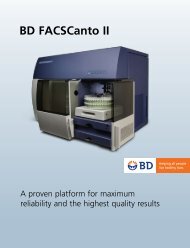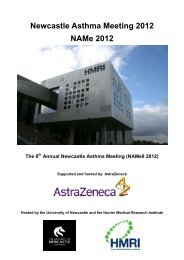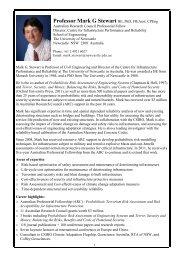n - University of Newcastle
n - University of Newcastle
n - University of Newcastle
Create successful ePaper yourself
Turn your PDF publications into a flip-book with our unique Google optimized e-Paper software.
The other consonants are sounded as in English.<br />
Europeans <strong>of</strong>ten confound dmith t, because <strong>of</strong> a middle sound<br />
which the natives use in speaking quickly ; so also they confound<br />
f with j, from the saxe cause.<br />
ACCENTS.<br />
The language requires but one marked accent, which serres<br />
for the prolongation <strong>of</strong> the syllable ; as, b 6 n, 'him' ; b 6 n, the<br />
ro,ot <strong>of</strong> 'to smite.' The primitive sound is thus retained <strong>of</strong> the<br />
rowel, which otherwise would be affected by the closing consonant;<br />
as, bun, the root <strong>of</strong> the verb 'to be' accidental, rhymes with<br />
the English word ' bun,' but b 6 n, ' to smite,' rhymes with<br />
' boon.'<br />
OETHOGRAPHT.<br />
In forming syllables, every consonant may be taken separately<br />
and be joined to each vowel. A consonant between two vowels<br />
must go to the latter ; and two consonants coming together must<br />
be divided. The only exception is Kg, which is adopted for want<br />
<strong>of</strong> another character to espress the peculiar nasal sound, as heard<br />
in ha n g e r, and, consequently, is never divided. The following<br />
are general rules :-<br />
1. A single consonant between two vowels must be joined to the<br />
latter; as, Lu-ri, 'man'; pu-rig 'away'; wai-ta, 'depart.'<br />
2. Two con~onants~oming together must always be divided;<br />
as, tet-ti, 'to be dead,' 'death'; bug-gai, 'new.'<br />
3. Two or more vowels are divided, excepting the dipthongs ; as,<br />
gato-a,'itisI'; yu-aipa,'thrust out.' Ahyphenis the<br />
mark when the dipthong is divided ; as, k 6 - u m a, 'may it<br />
be ' (a wish) ; k a-a m s, ' to collect together, to assemble.'<br />
4. A vowel in a root-syllable must have its elementary sound ;<br />
as, b 6 n k i 11 i, ' the action <strong>of</strong> smiting ' ; t a, the root-form<br />
<strong>of</strong> the verb, ' to eat.'<br />
ACCENTUATION.<br />
In general, dissyllables and trisyllables accent the first syllable ;<br />
as, puntimai, 'amessenger'; piriwil, 'achief or king.'<br />
Compound derivative words, belng descriptive nouns, have the<br />
accent universally on the last syllable ; as, mi y e 1 1 i k 6 n, ' one<br />
who speaks,' from w i y e 11 i, ' the action <strong>of</strong> speaking' ; so al~o,<br />
from the same root, w i y e 11 i - g k 1, ' a place <strong>of</strong> speaking,' such<br />
as, ' a pulpit, the stage, a reading desk.'<br />
Verbs in the present and the past tenses have their accent on<br />
those parts <strong>of</strong> the verb which are significant <strong>of</strong> these tenses ; as,<br />
tat6n, 'eats'; wiyhn, 'speaks'; miy6, 'hath told.' This<br />
must be particularly attended to; else a mere affirmation will<br />
become an imperative, and so on; as, k b- u w a, 'be it so,<br />
(a wish) ; k a - u w 6, ' so it is ' (an affirmation).<br />
THE GEAJIXAR. 3<br />
In the future tenses, the accent is xln~ays on the last s-yllable<br />
but one, R-hether the ~vord coilsists <strong>of</strong> two syllables or <strong>of</strong> more ;<br />
as, tbncn, ' shall or will eat' ; wiyBn~n, 'shall or mill speak';<br />
b 6 n k i 11 i n il n, ' shall or will be in the action <strong>of</strong> smiting' ;<br />
b 6 n n u n, ' shall or mill smite.' Present participles have the<br />
accent on the last syllable ; as, b 6 n lr i l l in, ' now in the action<br />
<strong>of</strong> smiting' ; m i y e 11 in, 'now in the action <strong>of</strong> talking, speak-<br />
ing.' Past participles hare their accent on the last syllable<br />
but one; as, b 6 n k i 11 i i l a, ' smote and continned to smite,'<br />
which, with a pronoun added, means ' they fought.' But the<br />
' participial particle, denoting the state or condition <strong>of</strong> a person or<br />
thing, has the accent on the antepenultilnate ; as, b 6 n t 6 a r a,<br />
'that which is struck, smitten, beaten.' Thus, there are two<br />
act:ents-one the radical accent, the other the shifting one which<br />
belongs to the particles.<br />
EXPEASIS.<br />
laced on the particle<br />
[THE PHONOLOGY OF THE AUSTRALIAN LANGV~LGES.<br />
late years increasing attention has been given to the contion<br />
<strong>of</strong> the Australian languages, and numerous vocabuhave<br />
been collected. But it is somewhat unfortunate that<br />
GENERAL FEATURES.<br />
king at the language as a whole, and examining its features,<br />
once observe the prominence <strong>of</strong> the long ~owels, ci and 6,<br />
e frequency <strong>of</strong> the guttura,l and nasal sounds ; the letter r<br />
deeper trill than in English, is also a common sound.


